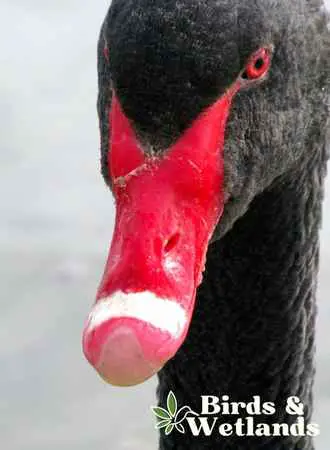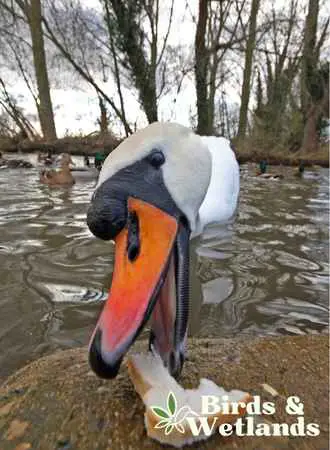Swans are known for their graceful and synchronized movements during mating dances, which is a sight to behold. But do swans have teeth?
Swans do not have real teeth. Serrated edges on their bills give an impression of them having teeth. The teeth-like edges, referred to as “lamellae,” provide a surface for clinging onto algae and trapping animals that are hard to grasp, such as frogs and fish.
Key Takeaways on Do Swans Have Teeth
- Swans have no teeth, but they have lamellae which look like small, jagged teeth.
- The swan’s bill is a highly adapted and specialized tool that plays a critical role in the bird’s survival and feeding habits.
- Swans have serrated tongues and strong beaks that help them with holding small prey.
How does a swan beak work?
A swan’s beak is made up of a basal knob and is specially adapted to filter food from the water. One of the key adaptations is the presence of lamellae, which are comb-like structures located on the edges of the beak and work the same way teeth function. These structures allow the swan to strain small aquatic organisms, such as plankton and aquatic vegetation, from the water as they feed.
The swan uses its beak to scoop up water and then pushes it out through the comb-like lamellae, which trap the food particles.
Unlike teeth, the swan’s lamellae are made up of keratin, the same protein that makes up human hair and nails. Additionally, the so called lamellae of present in the members of the Anatidae family which also includes geese and ducks, don’t have a protective layer covering the teeth called enamel.
The individual comb-like structures are made up of many small, parallel rows of keratin plates that are tightly packed together.
These flexible plates allow the swan to strain food from the water easily. The keratin plates are also very strong and durable, allowing the swan to use their beak to filter food from the water for many years.
In addition to the lamellae, a swan’s beak has other specialized adaptations. The beak tip is often slightly hooked, allowing the swan to grasp prey easily.
The beak is also very sensitive, allowing the swan to detect the presence of food in the water even in poor visibility conditions.
The comb-like lamellae, the hooked tip, and the sensitivity of the beak allow the swan to be a very effective filter feeder.

What does a swan’s bill look like?
Humans and other mammals have teeth used for biting and chewing their food.
Birds, on the other hand, do not have teeth. Instead, they have specialized beaks or bills adapted to their diet and feeding habits. The swans’ beaks are uniquely adapted for their diet of aquatic vegetation and small creatures.
The bill structure and shape is spatulate, meaning it is broad and flattened. This shape is perfect for scooping up aquatic vegetation, leafy greens, small seeds, small crustaceans and small insects, from the water’s surface.
The bill also has a sharp edge that allows the swan to cut through tough vegetation and is useful for probing in the mud and shallow water for food. They may not be the same as real teeth but a sharp bite can still draw blood.
The swan’s bill also has a series of small, comb-like structures called lamellae which are often mistaken as teeth. These lamellae filter food from the water as the swan feeds.
The swan dips its bill into the water, and as it opens its bill, water is forced out through the lamellae, which trap the small particles of food for the swans to swallow.
Finally, the tip of the swan’s bill is called the nail. It is a small bump or protrusion at the end of the bill that is used for grasping and manipulating food. The swan uses its bill to pick up food, and the nail helps to hold it in place as the bird eats. The nail often contrast with the bill color.

Do swans have teeth on their tongues?
Like many other waterfowl, swans do not have teeth on their tongues. However, they have lamellae, which are thin, comb-like structures on the tongue and bill. These jagged edges help the swans to filter food from the water and mud.
Swans use their tongues and bills to pull grass and plants from the ground. The lamellae or “swan teeth” on their tongues and bills act like a comb, allowing them to separate the food from dirt and debris. They also use their bills to dig for aquatic plants, invertebrates and small fish.
The lamellae on the swan’s serrated tongue also help them to hold on to their prey. The teeth-like structures on the tongue can grip and hold small fish and aquatic invertebrates, making it easier for the swan to swallow its food.
Do swans chew their food?
Mammals chew their food because it helps to break down the food particles into smaller pieces that the body can easily digest. The chewing process is facilitated by the presence of teeth in the mouth, which grind and crush the food as it is being chewed.
Additionally, chewing also releases enzymes in the saliva that aid in the breakdown of food. This process is essential for the proper functioning of the digestive system and overall health.
On the other hand, swans feed on plants and small prey floating on the water surface. Since they do not have teeth and therefore do not chew their food. Instead, they swallow their food whole or in large pieces. They have strong muscles in their throat and gizzard that aid in grinding and breaking down food.
Swans such as the trumpeter swans also have sharp edges in their gizzard that helps to grind the food. This adaptation allows swans to consume a diet of aquatic plants and small creatures that filter through their bill while searching for food.

Related Questions on Feeding Swans
Should you avoid feeding swans?
Feeding swans may seem harmless and loving, but it can negatively affect the birds. When swans are fed human food, they can become reliant on it and lose their natural foraging abilities. This aberrant behavior can lead to a decline in their overall health and well-being.
Additionally, overfeeding can lead to obesity, which can cause various health problems such as heart disease and joint problems. Swans getting their food directly from humans can be pretty aggressive and protective of their young ones and eggs especially during the breeding season.
Providing food to swans can be beneficial during the winter months when food is scarce. Providing supplementary food can help keep the birds healthy and strong during this time.
If you want to feed swans, steer clear from bread and other foods that are not part of their diet. Give them vegetables, fruits and frozen insects instead. If you want to feed them hard grain, grind it to small pieces so that the swans can properly digest it.
Swans eat all kinds of food but it doesn’t mean you should feed them.

Do swans have gizzard?
Like other birds, swans have gizzard. A swan’s gizzard is basically only a muscular organ that helps to crush food. Think of it as molar teeth in humans which help to grind food.

